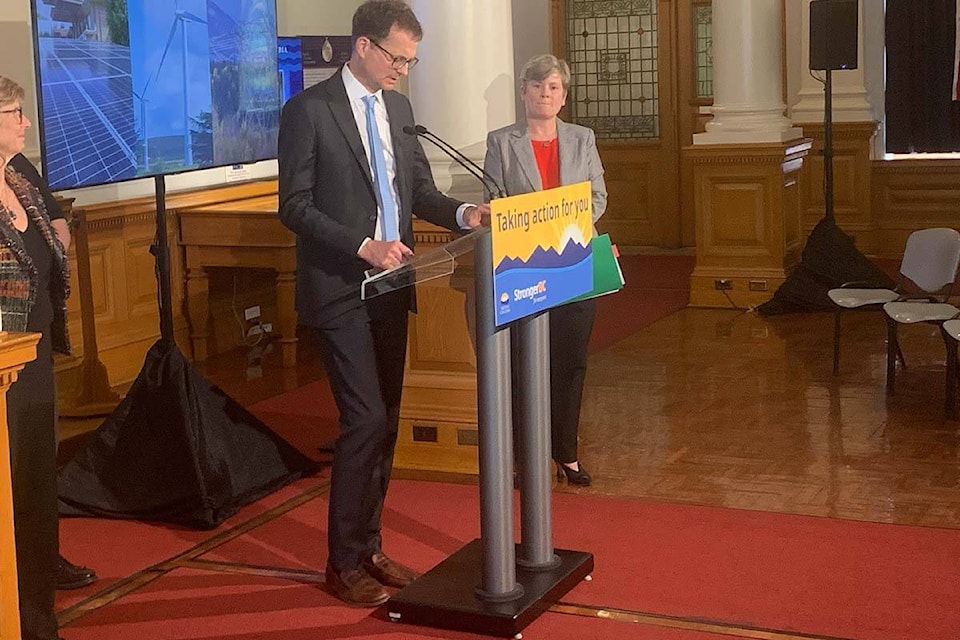Companies can start bidding on B.C. Hydro’s first callout in 15 years as part of a larger surge to generate more power in B.C., but the province will be importing power again this year amidst concerns about long-term supply.
“We are facing a lower snowpack as you have seen and that will trigger imports,” Chris O’Riley, B.C.’s Hydro president and chief executive officer, said Wednesday (April 3) at the legislature, where he joined Josie Osborne, B.C.’s energyminister, in announcing the formal request-for-proposals. “The exact amount (of imports) is actually quite variable…so we will see how that turns out.”
B.C. Hydro supplies and distributes 95 per cent of power to British Columbians, most of it through hydro-electricity.
“We manage the costs of that by spreading them over time and that has been a successful technique,” O’Riley said. “That has helped us manage the impact, so we’re not hitting ratepayers with immediate sharp increases.”
He said B.C. Hydro has been able to keep increases below inflation.
“That is our goal and we will be able to continue that in the coming years, including the effects of the drought.”
Osborne reiterated this commitment.
“We have made it clear to the (commission) not to see a rise in the rates above the cumulative rate of inflation,” she said.
Requests-for-proposals call for 3,000 gigawatt-hours from independent power producers. B.C. Hydro expects a dozen or so projects totaling between $2.3 and $3.6 billion in capital investments to meet this inaugural goal. Submission deadline is Sept. 16 with B.C. Hydro handing out the first contracts in December 2024. Chosen suppliers must become operational between Oct. 1, 2028 and Oct. 1, 2031.
This call for power comes as forecasts call for a 15 per cent increase in power demand between now and 2030. Factors leading to rising demand include population growth; increased industrial development, including mining; growth in zero-emission vehicles; rising use of fuel pumps in private residences; and more people working from home.
Riley said the inaugural call accounts for about five per cent of B.C. Hydro’s current supply, equal to about the power needed to power about 270,000 households.
RELATED:
RELATED:
B.C. Hydro expects that most of submissions will be for wind and solar projects, rather than run-of-the-river projects, with geography determining their distribution.
Riley expects the next call for power in 2026, subject to need, with future calls to follow, potentially every two years.
The call for power comes as Site C is expected to go online in 2024 with full completion scheduled in 2025. It will add about eight per cent to B.C. Hydro’s current supply.
B.C. Hydro also expects to meet demand through energy efficiencies; improved metering allowing consumers with solar panels to sell power back to the grid; optimal time of use rates; and improving existing transmission and generation.
B.C. Hydro is planning to invest $36 billion into what it calls sustaining and extending its system.
Former B.C. Liberal environment minister Barry Penner, who now chairs the Resource Works Energy Futures Initiative, welcomed the expansion, but has also wondered whether it will be enough.
“BC Hydro has already been a net importer of electricity for 4 of the past 12 years, with 20 per or one-fifth of our electricity coming from outside of the province last year,” Penner said in January. “We know that Site C alone won’t be the answer to all our energy requirements, more electricity generation is required.”
Electric vehicle targets and proposed shifts away from natural gas for home and commercial heating under Clean BC will have significant impacts on demand, he added. “There are outstanding questions on whether we will be able to reach those targets without becoming unsustainably dependent on electricity imports, a significant portion of which come from fossil fuel generation,” he said.
He reiterated these concerns about future supplies in late March.
“If 90 per cent of vehicles in BC were EVs (electric vehicles) — which is the required (percentage) for new vehicle sales by 2030 under the CleanBC climate plan — they will need the equivalent of (two) Site C dams of electricity (in normal water years),” he wrote on social media.
If 90% of vehicles in BC were EVs (electric vehicles) -- which is the required % for new vehicle sales by 2030 under the CleanBC climate plan -- they will need the equivalent of 2 Site C dams of electricity (in normal water years).
— Barry Penner (@BarryPenner1)
More discussion here:



